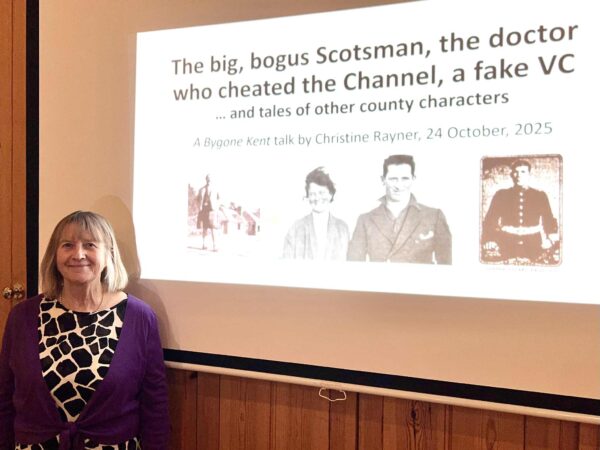Christine Rayner, journalist and co-publisher/owner of Kent’s only local history magazine, Bygone Kent, gave us historical insight into some local people who were “not quite what they seemed” when she spoke to us at a special fundraising event.

The event was held at Kingston Barn, with the hall packed full of Rotarians, guests and locals whose interest had been piqued by posters publicising the talk. Our President Raj Dasan welcomed everyone to the venue and reminded attendees of the main reason for the event: to raise funds for a Rotary Pentangular Project (JPP6) to raise funds for PTSD treatment for civilians – especially women and children – traumatised by the ongoing conflict in Ukraine.
Raj then introduced Christine who shared the story behind Bygone Kent, a magazine she and her husband Steve have run for nearly twelve years. Founded in 1979 by Rainham printer Hamish Mackay-Miller and initially printed monthly, the publication now appears six times a year. Over the years it has covered a wide range of local topics, from aviation to Victorian scandal! Christine brought some copies along for is to look at.
Christine’s first story featured larger-than-life Scottish actor James Robertson Justice, familiar to many older readers for his rather pompous roles in the comedy “Doctor” movies. It turns out his real name was James Norval Harald Justice and he wasn’t Scottish at all – in fact he was born in Lee, South London – then part of Kent. His father later bought a property in Hollingbourne. After studying science at University College London, and working as a journalist for Reuters – plus some dubious activity involving a revolver – he reinvented himself with a Highland persona, complete with kilt and booming voice. His certainly had a colourful life – rumoured to involve drinking, drugs and “a lot of women”. His long film career started in the 1940s, and his girth seemed to grow with his success. His 1975 obituary noted him as an actor of more than 20 stone in weight…and the voice of a “foghorn”.
The second character Christine spoke about was a woman called Dorothy Cochrane Logan. Dorothy attended school in Tonbridge and qualified as a doctor. She was also a strong swimmer and achieved brief fame in the 1920s – a time when many athletes were competitively trying to break speed records for crossing the English Channel. After two failed attempts Dorothy – wearing only axle grease and goggles – managed to set a remarkable Channel swimming record of 13 hours and 10 minutes! However, after a weekend of glory she confessed that her crossing was in fact an elaborate hoax, intended to expose the lack of regulation in such attempts. Both she and her trainer were fined and she narrowly missed being struck off as a doctor.
From the First World War came the story of Stuart Fagg, a gunner from near the Isle of Sheppey. Reports at the time hailed him as a hero nominated for the Victoria Cross (VC) – the story being that he and his colleagues has been captured by the enemy but had overcome the guard; all but Fagg had died. It was not until 100 years later that researchers found that much of the tale had been embellished and that there was no VC. Fagg had died at the age of 80 – never again mentioning the VC.
Next Christine posed the question: how did a Belgian actress get an English accent? The actress she was referring to was Audrey Hepburn, of My Fair Lady fame. It turned out that Audrey had partly spent her early years in Elham near Canterbury, having gone there with her mother following her parents’ divorce. Known then simply as Audrey Ruston, she attended a small private school run by four sisters, one of whom had a lasting influence on her. It was nice to imagine the future star enjoying a carefree childhood in Kent – and interesting to find out that one of the audience members knew someone who had been friends with Audrey at the time!
Christine’s next tale, a very Victorian scandal, involved a local curate called Alfred Winnifrith. It seems the curate was caught up in a relationship with a married woman named Rosa Hern. She had disappeared from her marital home, with her husband initially presuming she had gone to see family. In fact, she had been having the affair; her husband sued Alfred, who claimed to be the victim of gossip. The jury sided with the husband while Alfred continued to protest his innocence. However, a letter came to light and the subsequent perjury trial caused a sensation and ended in a sentence of hard labour for both Alfred and Rosa. But love won out when the couple later married and were eventually accepted by the Winnifrith family.
The final story for the evening centred on renowned author of the book, Lord of the Flies, Wiliam Golding. As a young writer he had met Ann Brookfield, an analytical chemist, at a literary event in London.
After a short Q&A session the evening ended with a raffle run smoothly by PP Peter Hermitage, supported by our own “elves” Karen and Aruna, and featuring prizes ranging from chocolates to fuzzy bath salts a very large blue teddy bear!
We are delighted that over £1,200 was raised in total for the JPP6 project, and a big bouquet was presented to Sue and Steven Thompson for their help in organising the event.
To learn more about our fundraiser, or to donate. click here.
Picture: Christine, pictured just before she gave her talk. Picture credit: Rotary Club of Canterbury.


